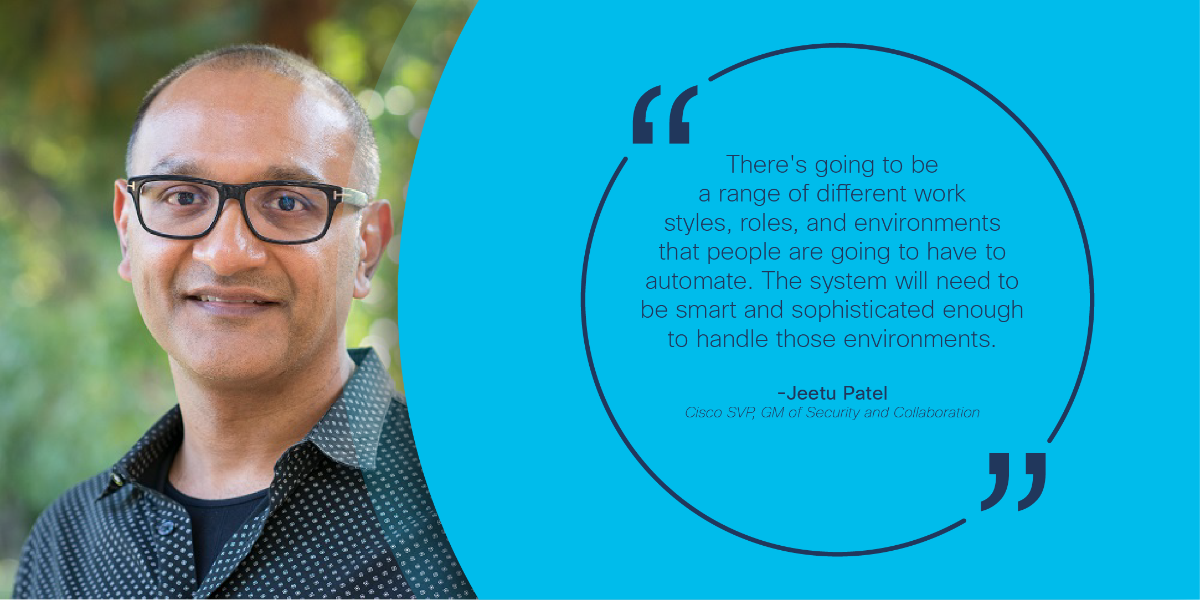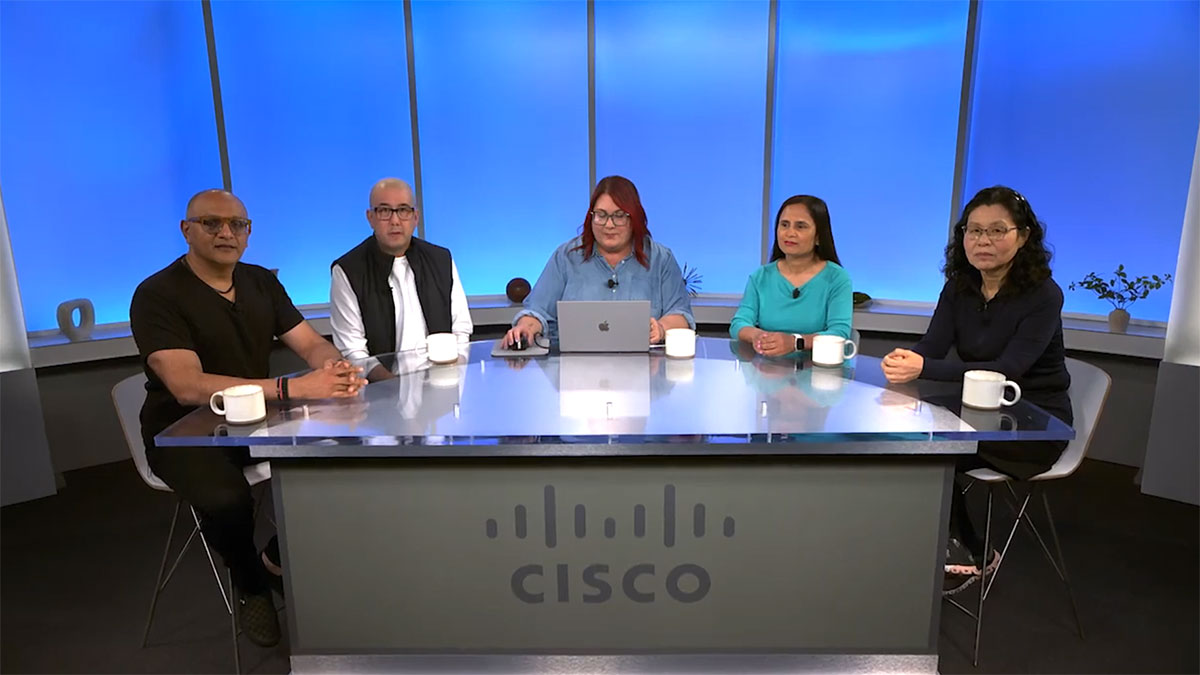As the dust of the previous 15 months settles, much about the future of our world is still uncertain. But as people return to the office, one area of growing consensus is that the future of work will be hybrid.
But what exactly will this future look like and how should you prepare for it?
In an effort to address these questions and capitalize on the learnings from the pandemic, Cisco has unleashed a tidal wave of innovation. One proof point: Webex by Cisco, the jewel of the company’s collaboration business, has added over 800 capabilities since last September.
Much of the innovation coalesces around five pillars. The company says successful hybrid work solutions must be: 1) secure, 2) managed, 3) flexible, 4) inclusive, and 5) supportive.
Secure
Hybrid work underscores the need for collaboration solutions to be secure — a challenge when participants and devices can be anywhere, moving in and out of company networks.
Among its innovations in this space, Cisco recently introduced zero trust security in Webex — a collaboration-industry first. Zero trust security protects against passive and active attacks by requiring certification from every meeting participant before they gain access.
See also: Transforming security with innovation and simplicity
In addition to end-to-end encryption, an extra layer of security provides stronger cryptography to meetings. It also verifies identity to keep meetings safe from the full spectrum of attacks. That means you don’t have to worry about hackers and imposters.
Managed
Hybrid work unleashes new demands for IT administrators. In addition to ensuring top-notch experiences for the main office or campus, they must now also do so for all the home offices and remote work locations, while managing an explosion of remote worker devices. Among the tools and capabilities Cisco offers here is Webex Control Hub. It empowers IT admins to support end users, devices, and environments, and to troubleshoot on the fly — all from a single pane of glass.
New integration of this hub with Webex devices allows IT to bulk manage devices in the hybrid workforce and push security patches or firmware updates more efficiently. And because Webex is built on a modern cloud infrastructure, it can readily handle the media and bandwidth demands of hybrid work where all meetings require video.
Flexible
As organizations get down to the nitty-gritty of making hybrid work real, one constant is emerging: fluidity — and with it a need for unprecedented flexibility. Work will be even more mobile than before the pandemic with people shifting between working at home, in the car, in the coffee shop, in the office.
“There's going to be a range of different work styles, roles, and environments that people are going to have to automate,” says Cisco’s Jeetu Patel, SVP and GM of Security and Collaboration. “And the system will need to be smart and sophisticated enough to handle those environments.”

That means pulling together more capabilities and integrating them with all the other systems in use. Cisco’s recently unveiled Webex Suite is a case in point. As the industry’s first suite for hybrid work, it will combine best-of-breed calling, messaging, meeting, polling, and events under a single license.
And it will work hand in glove with popular cloud applications. So if you need to login to Salesforce to get work done, you’ll be able to do so without leaving your workflow.
Inclusive
According to Cisco’s Global Workforce Survey, 98% of future meetings will include at least one participant who is not in the room. This presents a challenge: How do you make sure no one feels like a second-class participant Solving the nuances of this challenge is a priority for Cisco, for whom inclusivity is a core tenet. (The company’s mission statement is to power an inclusive future for all).
A successful hybrid model is driven by inclusion, connection, and participation, says Cisco’s Shari Slate, Chief Inclusion and Collaboration Officer and Vice President of Inclusive Future & Strategy.
“These are the gateway for creating value and impact,” Slate says. “With empathy as our superpower, we can define the hybrid world and create a world of work where people come first, where every voice is heard, and where nobody feels like an outsider — no matter where they are.”
Cisco’s approach melds the power of Webex with the use of physical space to create a seamless collaborative experience.
“This approach welcomes people to participate in work and life by removing the barriers to collaboration and connection and enabling people to participate from anywhere, anytime and on any device,” Slate adds.

Webex innovations in this space include real-time translations and meeting transcriptions from English into 108 languages and counting. Gesture recognition allows users to communicate non-verbally without having to tap icons.
Webex is also adding features that draw on Cisco’s “camera intelligence” technology. The first of these, dubbed People Focus, dynamically updates the screen layout to ensure that every meeting participant shows up equally, with their own box and their name and title displayed via face recognition.
Further helping to level the playing field are features that tap the company’s “audio intelligence” technology.
Webex’s new My Voice Only feature ensures that only your voice comes through in meetings, not the voices around you. And Webex can remove background noise — from barking dogs to leaf-blowers — through Cisco’s acquisition of BabbleLabs.
The net result: Everyone gets a fair shot at presenting themselves professionally no matter their location.
Supportive
The challenges of hybrid work cannot be solved by technology alone. One of the lessons of the past 15 months was that remote work took a human toll. A lack of human connection, for example, and anxiety and fatigue from endless meetings.
As people return to the office, Cisco is rallying a slew of innovations to address the human challenges of hybrid work. In fact, guided by its conscious culture, the company views the transition as an opportunity to reshape the future of work. In addition to its Webex innovations, Cisco’s approach here draws on its strategies around devices, smart buildings, and software.
One example is the way Cisco’s wireless access points, Meraki security cameras, and DNA Spaces (Cisco’s location and IoT platform) work with digital signage to help people feel safer in the office.
Together, these technologies can let people know the real-time occupancy of meeting rooms, provide alerts when occupancy thresholds are reached, help find available meeting rooms, and more. And when you enter a room, Webex can automatically wake up and touchlessly launch a meeting.
AI-powered devices like WebEx Desk Pro and WebEx Desk Camera can help reduce meeting fatigue for frontline employees working from home. And a powerful capability called People Insights for Webex helps employees manage their time, improve their well-being, integrate work and life, collaborate more inclusively, and be more productive.
Cisco’s case that successful hybrid solutions must meet these five criteria may be compelling, but the proof will be in the pudding. Patel recommends that enterprises take a step back to really assess their needs in this new era.
“Hybrid work is going to be harder to adjust to than everyone working in the office or everyone at home, because there are nuances,” he says. “We're all going to need to adjust.
###
Related content:
Transforming the internet for the future




